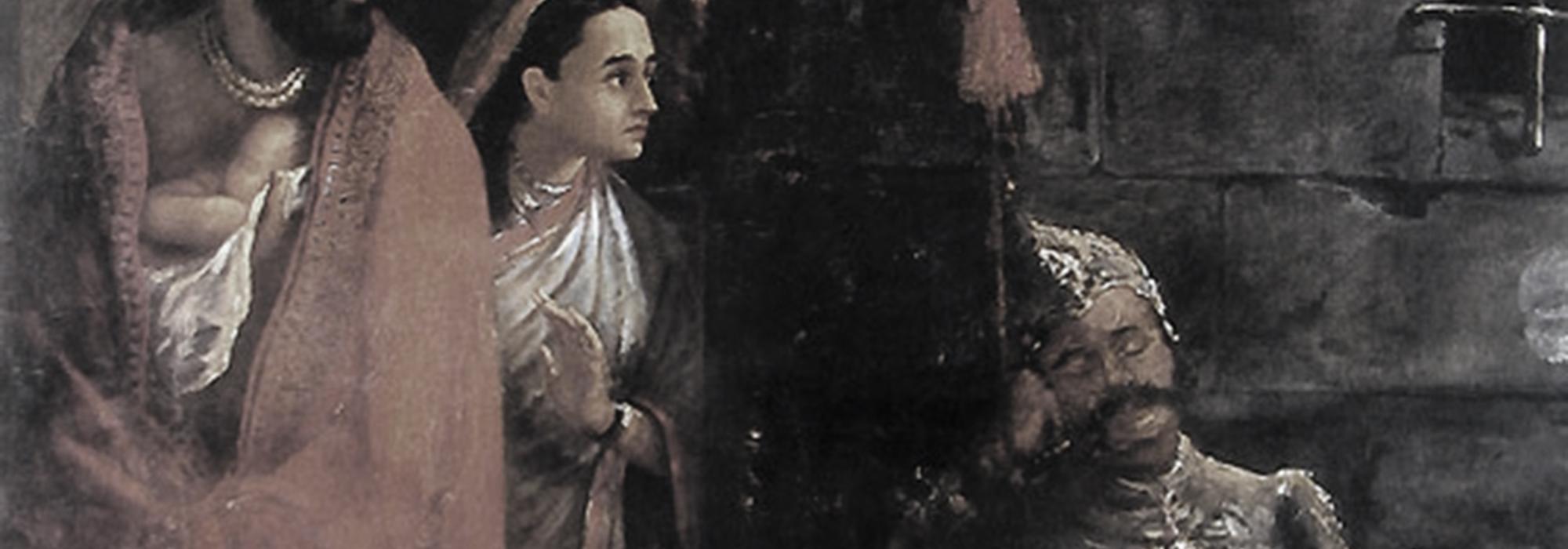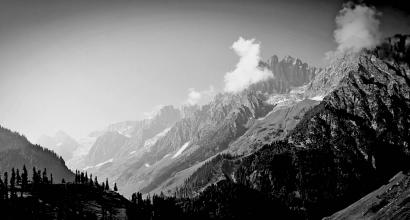In the previous episodes, we discussed about Shiva being an ideal at the level of the individual and Rama being the family ideal. We will now look at the life of Krishna, the ideal at the social sphere.
Whenever artists paint images of Shiva, Rama, or Krishna, or even say, Durga, or Kali, or Skanda, or Ganesha, they always include the weapons that are typical to those deities. Shiva has a triśūla, Rama has a bow, Krishna has the sudarśana cakra, and so on. There seems to be some discomfort in some quarters about such portrayals of our deities. Why should one be unhappy or ashamed if Rama carries a bow or if Krishna kills someone? Rama is not just the husband of Sita, he is also the destroyer of Ravana. For the sake of his family as well as for larger good, he destroyed an evil man. Krishna is not just the cowherd boy playing with his friends in Gokula, he is also the killer of Kamsa and others.
The Indian tradition is one of courage, not cowardice. While self-restraint and non-injury are lauded, greatness is not in showing the other cheek. In the Taittirīyaśākhā of the Kṛṣṇayajurveda we have a famous mantra that says, “Those who hate us and those whom we hate, let us cut off their necks!”
योऽस्मान् द्वेष्टि यं च वयं द्विष्म इदमस्य ग्रीवा अपि कृन्तामि
Baudhāyana Śrautasūtra 4.2.110
Rājadharma tells us that “the five yajñas to be undertaken by a king are: punishing the wicked, honouring the good, increasing the treasury by fair means, dealing impartially with litigants, and protecting the kingdom.”
दुष्टस्य दण्डः सुजनस्य पूजा
न्यायेन कोशस्य च सम्प्रवृद्धिः।
अपक्षपातोऽर्थिषु राष्ट्ररक्षा
पञ्चैव यज्ञाः कथिता नृपाणाम्॥
Ātreyadharmaśāstra 28
(We find the same verse in Varāhamihira’s Yogayātra 2.33 and in the Vikrama-carita)
It is a duty of a kṣatriya to protect the helpless and punish the wicked. This awareness of kṣātra has been clearly spelled out by our ancient thinkers and philosophers. Sanātana Dharma emphasizes the harmony between brāhma and kṣātra. While the former is spiritual, pertaining to learning and intellect, the latter is physical, pertaining to courage and protection. All our deities—gods and goddesses—adorn themselves with a flower or an ornament or a musical instrument as well as weapons of war. Our deities have a charming poetic side and an awe-inspiring warring side.
There is a notion among some of our people—ancient and modern—that Krishna is a cheat, a fraudster, a master of deceit. Nothing could be further from the truth. The ancient thinkers have always held that a person who is strong, wise, and unselfish – he or she can resort to any means. If one has the authority and the courage; if one is learned and adheres to dharma; and if one is free from all personal agenda, then whatever that person does becomes correct. That person will never err. Krishna was such a person.
Shiva is called Shambu or Soma, indicating that he is an ātmārāma, one who is peaceful within. Rama is one who is ramaṇīya, a person who is loved. An embodiment of family values. The word ‘kṛṣṇa’ is derived from ‘karṣati iti kṛṣṇaḥ’ – that is, he is one who attracts. Apart from ‘attractive, Krishna also means ‘dark,’ ‘black.’ In his very name we see a hidden aspect, an obscure element.
Rama and Krishna are both said to be avatāras of Vishnu. It is interesting to contrast their births. Rama was born during the day, in the śuklapakṣa (the fortnight of the waxing moon), during the month of Caitra, in Vasanta (spring), during uttarāyana (bright half of the year). Krishna was born at midnight, in the kṛṣṇapakṣa (the fortnight of the waning moon), during the month of Bhādrapada, during Varṣa (monsoon), in dakṣināyana (dark half of the year). Rama was born as the eldest son, in a palace, amidst so much expectation and celebrations. Krishna was born as the youngest son, in a prison cell, amidst fear and a death-threat.
While Rama was born in the morning of a bright day, Krishna was born on a stormy night. The clouds have covered the moon. Lightning typically strikes at the start of the rain but it doesn’t appear when there is heavy rain. There is also no chance to light a fire with such heavy downpour. No sun, no moon, no lightning, no fire; absolutely no light.
However different from each other, both Rama and Krishna had births. But what about Shiva? He is birthless. When is the ‘I’ born? Do we remember the birth of our ego? We can point out the birth of a family or that of a society but the birth of the self is impossible to tell. The beginning of my knowledge is my birth. But I don’t know the starting point of my knowledge. Based on this knowledge of mine, I cannot fathom my birth, i.e. the start of my knowledge. This is not possible; just like we can’t climb on our own backs! From this point of view, Shiva is without birth.
Rama has a great birth. He was born to a great king in a huge palace amidst celebrations in the whole of Ayodhya. That is exactly how we want our family life to be, isn’t it? Bright, joyful, festive, transparent. In the family realm, we have a great deal of control but it is totally different when we move to the sphere of society. In a family, it is possible for all the members to be happy and peaceful, but in a society, can all subjects be happy? Krishna’s name and birth indicate the diversity that we see in society. When the whole world is engulfed by tamas, in the middle of a dark night, a dark child is born and he brings light to the world – this is the story of Krishna. This is such a wonderful virodhābhāsa! The child born in jail broke the fetters that bound the society!
Rama took care of his family, he saved his wife from the clutches of Ravana, he ruled over the kingdom – in many ways he was successful in his life. But what about Krishna? He did everything within his power to save the society but in the end, he did not succeed. In the Rāmāyaṇa, Rama could be proud of his victory over Ravana. But in the Mahābhārata, Dharmaraja’s victory is not so. After the war, he says, “I feel that even this victory is just defeat.”
जयोऽयमजयाकारो भगवन् प्रतिभाति मे।
Śāntiparva 1.15
When we undertake something at the level of society, the result will be beneficial to some but will also be harmful to some. A few will look at it as a success but there will also be a few who look at it as a failure. In our family, we can say that such-and-such an undertaking was successful but how to judge it in the societal sphere?
This is the difficulty in Krishna’s life. Without assuming any position, without hijacking any seat of power, he tried to help people of all stations as much as possible. He did what is best for the world.
In the family, we can say that so-and-so is the head. A certain individual in the family manages it and takes decisions. He or she is responsible for the family in all respects. But who can be a leader of the society? It is really difficult. One has to be really careful before setting out to be a leader of the people. Often, it is better to be a supporter or a nourisher of a good leader of society. Krishna never became king. He supported good kings in every way he could. He embodies goodness in society. At every stage he tried to protect the welfare of the common people; he worked for universal well-being.
Krishna was separated from his parents at birth. He grows up with foster parents and realizes the truth about his parents only as a teenager. He doesn’t get upset by it. Krishna is a great example for how a person with a vision for society and a desire to serve the world cannot be troubled by family affairs and personal emotions; he has to transcend them. Rama, on the other hand, was so attached to his parents.
Krishna did all the work he was supposed to do but never got attached to it. After being separated from them at birth Krishna saw Devaki and Vasudeva only when he was thirteen or fourteen. Even after meeting them, he maintained good relations with them but was never overwhelmed; he was not trapped in their emotions. He also loved and respected his foster parents Yashoda and Nandagopa. But once the time came, he walked away from there. Can we call this ingratitude? Not in the least. He loved them, he cared for them, but his affection for them did not make him overwhelmed to the point that he was washed away by attachment. He didn’t kill himself for the sake of relationships.
Rama’s life is replete with such instances. He often says that he undertook such and such an activity for so and so person. Rama was driven by responsibility but also by emotions. We don’t see this in Krishna. Indeed, Krishna worked tirelessly for the sake of the Pandavas but he showed no sorrow or pain at the death of the children of the Pandavas, be it Abhimanyu, Ghatotkacha, or the five children of Draupadi. Does this mean he only cared about the Pandavas? Even they were not imperative for him. He supported them because they were the best among the rest.
To be continued.
This serialized article has been translated by Hari Ravikumar from the author’s Kannada lecture held at the Gokhale Institute of Public Affairs, Bangalore in 2009.



































